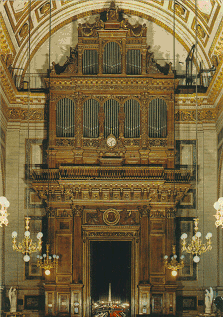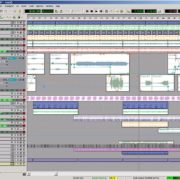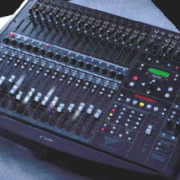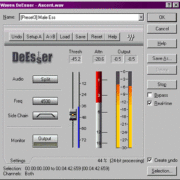PLEASE NOTE: This article has been archived. It first appeared on ProRec.com in January 2000, contributed by then Contributing Editor Bruce Richardson. We will not be making any updates to the article. Please visit the home page for our latest content. Thank you!
The Peter Ewers Symphonic Organ Samples are yet another example of the incredible toolset GigaSampler brings to orchestral composers.
The Peter Ewers Symphonic Organ Samples library serves up three different perspectives on one of the most significant pipe organs in the world, the Grand Cavaille-Coll Organ at the Eglise de la Sainte Madeleine in Paris. This organ was at the forefront of the transition to the modern pipe organ. But it is no dinosaur. To this day, it is widely recognized as one of the finest instruments ever constructed.

Folks, take a moment and really consider this. We can have the authentic sound of a 150 year-old pipe organ come alive in our studios and in our performances. And if that weren’t enough, we get the sound of its build and decay into the cathedral itself.
This is realism with more than sonic significance. If you could set up a recording session in this very cathedral, and play your parts live on this very instrument, you might not come away with as good a recording as you can get with this library. And you would certainly not be able to revisit the instrument every time you got the urge. Think of this: if this organ were destroyed tomorrow, its sound would live on, thanks to this sample library. It’s big stuff in my book.
Sampling the Pipe Organ
Pipe organs (actually all sustaining instruments) are difficult to sample. The sound changes infinitely over time. No matter how you loop a pipe organ note, you’ll notice the loss of vitality as it hits its repeating state. Yet, even with GigaSampler, how does one avoid looping? Notes can’t go on forever, even when you’re sampling into the gigabyte-plus library sizes we’re beginning to see.
On this library, we’re given LONG samples that have no loops. Eventually, they simply end. There are a few times when I ran out of “note” on this instrument, but not many, and none at all in actual performance.
You will only find yourself running out of tone when you’re sitting in the studio playing around. You’ll find yourself holding out chords forever just to hear the beautiful and ever evolving sound. It’s addicting. You just want to hold it longer and turn the monitors up louder.
The cathedral reverb is a great trick. As you release a note, instead of a gate, you advance to the end of the sample–where the actual cathedral resonance begins. So, as you’re playing the instrument, you hear the tones building up more and more the longer you hold a note, and each note’s recorded tail as you release.
If you analyze the paradigm closely, you’ll realize that this isn’t exactly the way the acoustics work, but it is plenty close enough.
The illusion is amazing, and playing this instrument is a ball. Recording it is a treat as well. I have used it many times in some very public projects, and people never fail to comment on the beauty and power of the organ sounds. Trust me, you’ve never heard any electronically generated pipe organ sound that can match it.
So, What’s the Catch
In a recording environment, none. Some folks have commented on the cathedral reverb. You can turn the release samples off, and simply use outboard reverb, if the long reverb tails are creating problems with your mix.
You might also want to go sans reverb if you play the library in live performance. Suppose you’re playing in an actual cathedral with your trusty GigaRig. It’s a better idea to let the performance venue put its own resonance on the samples, and just add a bit of the cathedral resonance or outboard reverb if you need it. The sonic imprint of the original cathedral could be too distinctive to use in this context, and might actually compromise realism rather than enhance it.
I have spoken to organists who question the decision to provide only three “setups” of stop combinations (and of course, two different pedal setups as well). The stated intention of the producers was to provide the most-often performed combinations. On this point, I tend to agree with the detractors. I would love to roll my own combinations of pipes. After all, I am NOT an organist, and I might come up with an amazing combo that’s far too outside the box for someone with a “purer” perspective to consider.
Given that reservation, I will say that the choices Mr. Ewers made are good-sounding and useable. The tutti is huge and room filling, while maintaining that amazing transparency of sound that no other instrument can quite match. The two smaller combinations are sweeter in nature. The 16′,8′,4′ combo is well articulated and complex. The smallest-sounding 8′ combo is simply divine, a floating swirl of color. All awash with the release resonances, it sounds like the music they’d play in heaven. An amazing instrument all by itself, with uses that are not limited to traditional organ music. I’ve used it as a synth pad with fine result.
Some of the notes have extramusical sounds that are a result of noisy mechanisms in the organ itself. This is not the only sample set with this characteristic, but it certainly has a few great examples. My guess is that these are included because they are authentic and charming.
My perspective differs a bit. When you’re dinking around with the samples and just enjoying, these little quirks are indeed rather charming. On the other hand, when you’re battling a deadline at the eleventh hour, and one of those charming bellows-farts is making your woofers pop out of the basket, the charm fades. I would encourage instrument designers to bear this in mind, and let the timbres speak for themselves. There’s no need to force additional realism in the form of mechanical defect, since this will nearly always inconvenience the end user. Capture the “defect” sample, catalog the sample to be sure…but when building the actual sampled instrument, avoid single notes that call too much attention to themselves. They come back to haunt.
That’s a rather lame criticism on my part, really more of a user wish, and at most an artistic difference of opinion. I can see why it would swing either way, depending on who makes the call. Peter Ewers Symphonic Organ Samples is a class act through and through, capable of transporting you to a seat at one of the most celebrated pipe organs in the world. Organists will want it just for the joy of playing it. Composers get an instrument of beauty and authenticity that would be impossible to afford on any but the highest production budgets. Another amazing tool, within the grasp of anyone that needs it.



